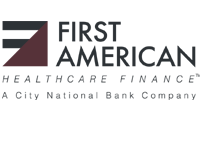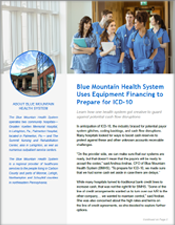Resource:
Blue Mountain Health System Uses Equipment Financing to Prepare for ICD-10
Learn how one health system got creative to guard against potential cash flow disruptions.
In anticipation of ICD-10, the industry braced for potential payor system glitches, coding backlogs, and cash flow disruptions. Many hospitals looked for ways to boost cash reserves to protect against these and other unknown accounts receivable challenges.
“On the provider side, we can make sure that our systems are ready, but that doesn’t mean that the payors will be ready to accept the codes,” said Andrea Andrae, CFO of Blue Mountain Health System (BMHS). “To prepare for ICD-10, we made sure that we had some cash set aside in case there are delays.”
While many hospitals turned to traditional bank credit lines to increase cash, that was not the right fit for BMHS. “Some of the line of credit arrangements wanted us to turn over our A/R to the other company… we wanted to maintain control,” said Andrae. She was also concerned about the high rates and terms on the line of credit agreements, so she decided to explore further options.
To boost cash reserves, Ms. Andrae considered an option presented by First American Healthcare Finance: a sale and leaseback for previously purchased equipment. In this transaction, the health system received a cash reimbursement for medical and IT equipment purchased within the past 12 months. In exchange, the system made low, fixed payments for a set period of time. In comparison to the bank credit lines, the equipment financing solution presented lower rates, more flexible terms, no blanket liens, and allowed the system to maintain control.
With all options considered, the cash reimbursement was the best fit for the system’s needs. BMHS opened a lease line of credit through First American and immediately used a portion to put cash back on the books. The balance of the line may be used over the next three years for any equipment, renovation, or software needs. More importantly, there are no under- or nonutilization fees like those commonly found with traditional bank credit lines. “That is another way we can protect the cash we have coming in for the next couple years,” said Andrae. “Since we have that open line, we do not have to use cash for capital purchases.”
Although there are many facets to the ICD-10 transition, working with First American helped BMHS feel more prepared for the financial implications of the code set’s arrival. With a stronger cash position secured, both BMHS hospitals can focus on getting charts coded, getting bills out the door, keeping DNFB under control, and keeping cash coming in – all while maintaining a high level of patient care.
ABOUT BLUE MOUNTAIN HEALTH SYSTEM
The Blue Mountain Health System operates two community hospitals— Gnaden Huetten Memorial Hospital, in Lehighton, Pa.; Palmerton Hospital, located in Palmerton, Pa.— and The Summit Nursing and Rehabilitation Center, also in Lehighton, as well as numerous outpatient service centers.
The Blue Mountain Health System is a regional provider of healthcare services to the people living in Carbon County and parts of Monroe, Lehigh, Northampton and Schuylkill counties in northeastern Pennsylvania.

